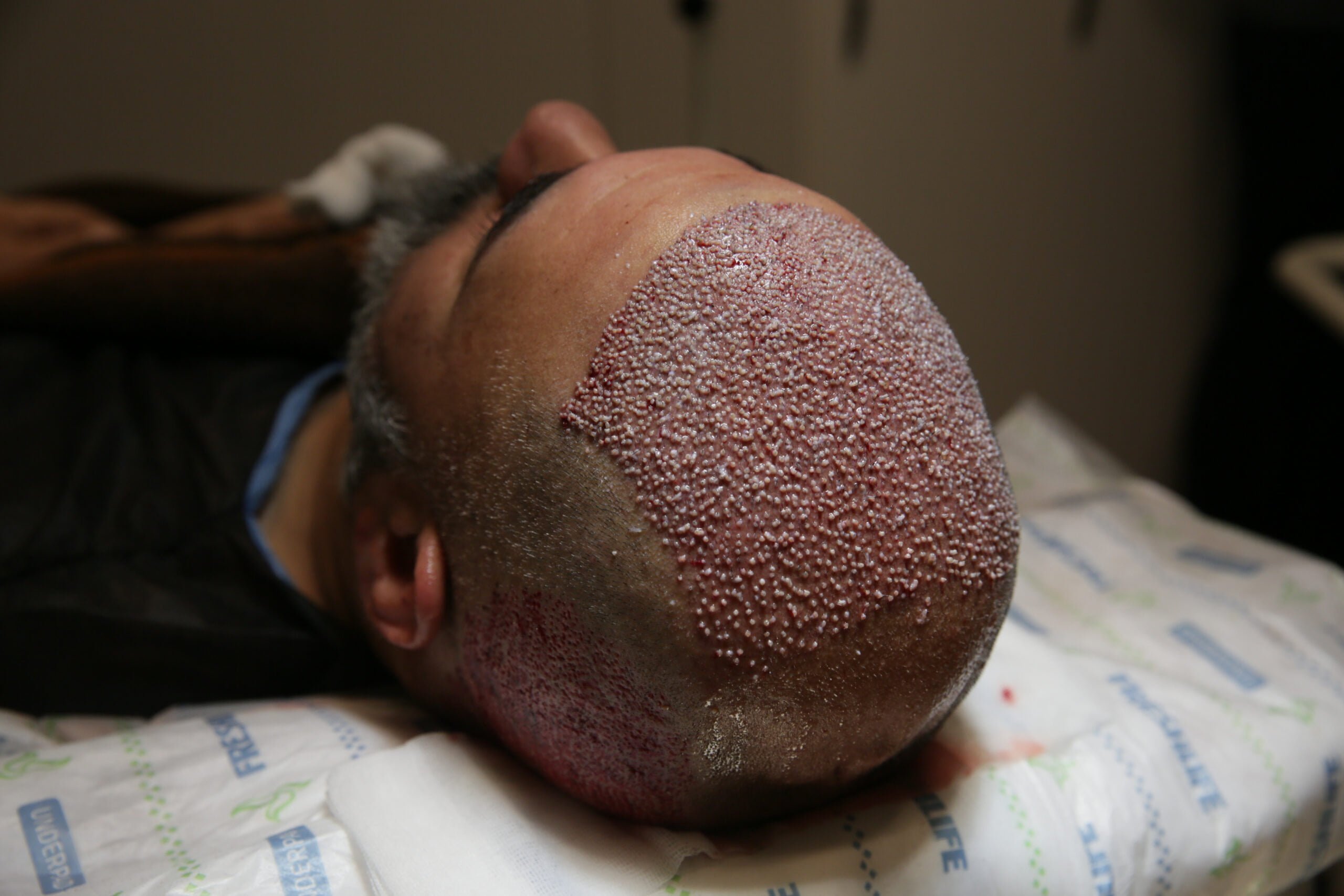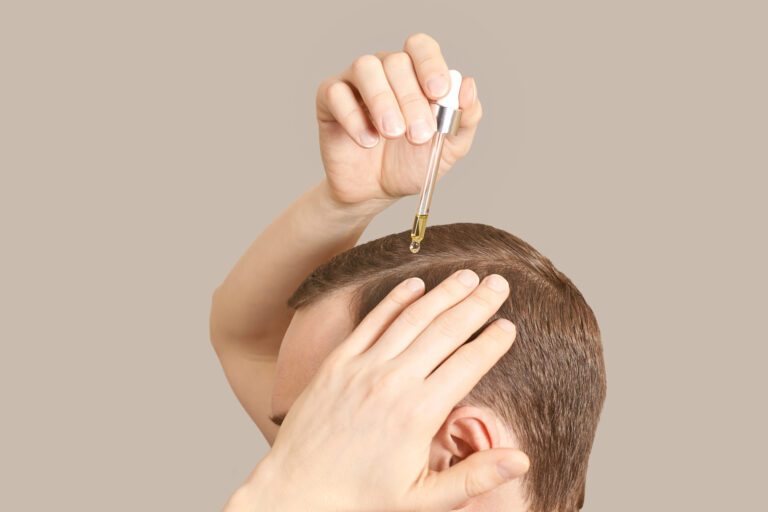Swelling After a Hair Transplant: What to Expect & How to Reduce
Although modern hair transplant techniques are safe and non-invasive, they’re not without risks. After all, a hair transplant is a surgical procedure that causes some extent of trauma to the skin.
Swelling is the most documented side effect of any hair restoration procedure. Thankfully, it resolves in a few days and doesn’t leave any permanent damage. Still, you’ll want to know whether the condition is limiting and how to manage it.
In this article, learn more about hair transplant swelling. We’ve also put together several tips to reduce FUE swelling.
What Causes Hair Transplant Swelling?
After a few days without pain or other symptoms, you might suddenly wake up with a puffy face. It’s not surprising, as hair transplant swelling happens in most patients.
Here are the two chief causes of hair transplant swelling:
Fluid Buildup
Follicular Unit Extraction (FUE) involves the injection of a diluted local anesthetic. It’s usually a saline solution containing lidocaine and epinephrine. This delivery technique causes the tissues to become firm and tense.
Technically, the transplant sites become tumescent or swollen. This method makes it easier for surgeons to harvest and implant hair grafts.
After infusion into the skin tissues, the fluids from the anesthesia enter the bloodstream. Then, the forehead and eye areas swell as the fluids travel down and finally exit the body through the urine.
Note: the medical term for fluid buildup and retention is edema.
Inflammation
Inflammation is another cause of hair transplant swelling. FUE uses an excision device to harvest grafts of healthy hair follicles from the donor site. The technique leaves behind tiny punctures on the scalp to the depth of the mid-dermis.
Aside from that, the surgeon uses an implanter pen or makes incisions on the recipient site to insert the hair grafts.
The body treats these surgery marks as wounds and activates the immune system’s first responders—cytokines and inflammatory cells. This response aids in healing injured tissues and trapping bacteria and other harmful foreign agents.
In addition, the skin becomes red and puffy as blood cells rush into the area to fight infections. Alert your surgeon if you’re experiencing other symptoms, including:
- Pain
- Pus-filled abscess
- Itchiness
- Fever and headaches
- Swollen lymph nodes
- Lethargy
How to Reduce Hair Transplant Swelling
Follow these tips to reduce hair transplant swelling and speed up your recovery:
1. Take Your Medicines
Your surgeon may prescribe steroid meds—prednisolone—for you to take before and after the surgery. Steroids are potent drugs that can bring down inflammation, and these are your best option to reduce swelling.
Your aftercare kit may also include antibiotics to prevent infection. Complete the course of your medication to ensure a smooth recovery following a hair transplant.
2. Sleep in a Semi-Upright Position
Tilt your head at a 45° angle when you’re lying down by propping your head on several pillows. Always sleep on your back during recovery, especially if your grafts are at the front of your head.
Keeping your head elevated above your heart pulls fluids away from the site of inflammation. Not just that, but it keeps the hair grafts intact.
3. Avoid Intense Physical Activities
If your job entails hard physical labor, take at least a week of rest to allow the swelling to subside. You may also need to postpone any form of exercise, like running and lifting weights.
Blood rushes to your head as your blood vessels dilate after an intense workout. Although this is fine under normal circumstances, the pressure can burst blood vessels and worsen swelling.
Physical exertion can cause further trauma and tissue damage to your hair transplant wounds, resulting in more inflammation. Besides, it often leads to sweating, which can attract infection-causing bacteria.
You can hit the gym safely after 2 weeks, as long as you don’t have any lingering post-surgery effects.
4. Use Cold Compress
Use an ice pack, a bag of frozen veggies, or ice cubes wrapped in a washcloth to relieve postoperative swelling. Alternatively, you can freeze a hydrogel mask and drape it over your eyes to treat periorbital edema.
Press the cold compress lightly on the swollen skin for 15 minutes every 2 hours, avoiding the hair grafts. Icing reduces inflammation by constricting the blood vessels and slowing down blood flow to the area.
5. Stay Hydrated
Remember that water is essential in flushing out toxins and wastes from the body. Drink plenty of water before and after your surgery if you want to drain all residue from the anesthetic solution fast.
In addition, cells need water to produce energy and repair themselves. If the body is dehydrated, the cells break down and release inflammation-causing enzymes.
In short, dehydration not only hinders tissue repair in hair transplant injuries but also promotes swelling.
6. Avoid Certain Medications
Steer clear of ibuprofen and other non-steroidal anti-inflammatory drugs (NSAIDs) as they cause fluid retention and swelling. Instead, take paracetamol to manage your pain.
7. Massage Gently
Use your fingers to apply gentle sweeping strokes, starting from the center of your forehead and moving outwards to the sides. Massaging can push the fluids underneath the skin and bring the swelling down.
However, be careful not to tug your skin, as delicate hair grafts can get dislodged.
8. Eat Plenty of Anti-inflammatory Food
Consuming foods with inflammation-busting properties is a natural approach to reducing face swelling hair transplant. Eat antioxidant-rich foods such as nuts, dark greens, and deeply colored fruits.
Incorporate fish in your diet as it contains omega-3 fatty acids. Healthy fats are excellent at fighting inflammation as well. Additionally, foods high in vitamin C speed up wound healing and fight infections.
What Factors Affect Hair Transplant Swelling?
Some people are more prone to experience postoperative swelling because of these factors:
- Age
- Number of hair grafts
- Length of procedure
- Skin laxity (looseness)
How Bad Can Hair Transplant Swelling Get?
People experience FUE swelling to varying degrees. Some patients have mild swelling that doesn’t interfere with their daily routine.
Others experience significant swelling that affects their appearance and prevents them from going out. There are rare cases when the eyelids get so swollen that patients cannot open their eyes.
You can assess the severity of your swelling by using this scale:
- Grade 0: No visible swelling
- Grade I: Swelling around the hairline
- Grade II: Swelling on the upper and lower forehead
- Grade III: Swelling around the eye areas (periorbital edema)
- Grade IV: Periorbital edema with blackeye (ecchymosis)
Regardless of severity, swelling is temporary and doesn’t cause long-term complications, so you need not worry.
Note that hair transplant swelling face symptoms start 2–3 days after the procedure and can last for 3–4 days.
Can You Avoid Hair Transplant Swelling?
Steroid treatment is the most effective way to address hair transplant swelling, especially in patients who get a frontal hair transplant.
Some surgeons inject a low-dose steroid, along with the tumescent solution, before making graft incisions on the recipient site.
In one study, 97% of the patients who received a steroid showed no postoperative edema. Meanwhile, the remaining percentage only experienced mild swelling.
Other doctors give oral or injectable steroids before and after the procedure to reduce swelling. Talk with your provider to discuss your options if you find hair transplant swelling a major concern.
Summing Up
Many patients experience hair transplant swelling as a side effect within the first week of the procedure; it’s not really uncommon.
On that account, if you’re getting a hair transplant soon, it’s best to consider downtime for FUE swelling so you can plan your work schedule ahead of your procedure.
We recommend following your surgeon’s aftercare instructions to reduce swelling and shorten recovery time. You can also use the above tips to speed up healing so you can return to your usual routine ASAP!







